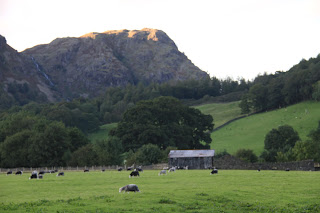The Lake district, Coniston and lake Windermere
Went off to England for a few days not really the right thing to do as my health is rapidly deteriorating but there are some places I wanted to visit lake Windermere and Coniston being part of them. my first nights B AND B, was just outside Coniston one of those places that does not get a mention in travel brochures etc but has its own website www.browsideconiston.co.uk/
one of those places one can just relax with great views from the room I had I could just sit or even lie in bed and take in the silence and views. Getting ready for breakfast I took this shot from the dinning room almost looks like it had some frost in the night, Because I have so much to put on my post I will be putting some photos on my sister blog. today I will be putting viaducts, aqueducts ,bridges and unused rail bridges some of which have not been used science the early 60s and one opposite the B and B that was used to haul from the copper mines that closed in the 30s.photos from around wales in this case its England

Sheep I have not seen before grazing outside the bandb window.
The Herdwick is a particularly hardy sheep, capable of living on the roughest terrain with scant vegetation and the country's highest rainfall. The fleece is dense and dries out much more quickly than the fleeces of other breeds. Herdwicks have a distinctive grey fleece, white heads and sturdy legs. The lambs are born largely black in colour, with their heads and legs becoming white and their fleeces becoming lighter as they age.
Herdwick sheep are generally now found in the central and western dales of the Lake District. But, originally, their range was much greater than this, extending from Caldbeck in the north to Low Furness in the south and stretching all the way to Shap and Kentmere in the east.
Although it has not been proven that the Herdwick is of Scandinavian origin, there is no doubt that Viking settlers from the 9th century were great keepers of sheep in the fells. The name derives from 'herd-vik' (Old Norse for 'sheep farm') and later became associated with the breed itself.
talk about free range there was six of these mixed chickens who had free range of the field with the sheep. and for breakfast I had scrambled eggs . 4 young barn swallows at 19.30 had settled down in their nest for the night. the nest was under the low canopy roof of the log shed.
These two butterflies the peacock and tortoiseshell where basking in the early morning sun
Mist rising from Lake coniston.
This little chap has its own safety jacket maybe its one of those rare breeds that cannot swim?
Sundown over the Lake district
This rowing boat on Coniston lake has the same name as my artist niece. see her stuff on here
SWALEDALE SHEEP
Swaledales have proved to be very adaptable hill sheep due to their relative hardiness and good mothering abilities. There are now an estimated 2,500,000 Swaledale sheep in the country, largely in the northern uplands of England making them the most economically important hill sheep in England.
The Swaledale Sheep Breeders' Association was established in the early 1920s by sheep farmers who lived within a seven mile radius of the Tan Hill Inn (near where the counties of North Yorkshire, Durham and Cumbria meet). An important gathering of Swaledale sheep and their breeders still takes place in mid May at Tan Hill.
Of the 1200 pedigree flocks nationally, about a third are in Cumbria. These flocks produce tups for the many commercial Swaledale flocks in Cumbria and beyond. Kirkby Stephen is famous for its Swaledale tup sales which take place in mid-October.
The Swaledales have also been responsible for producing the most numerous sheep of the lowlands - the North of England Mule. By using tups of the Bluefaced Leicester breed on Swaledale ewes, crossbred lambs of great hybrid vigour and commercial potential are produced. Swaledale genetics, therefore, influence a significant part of the national sheep population.
The sales of Mule gimmer lambs at auction marts all over the northern uplands of England are impressive sights. In and around the Fells and Dales there are important sales at Kirkby Stephen, Lazonby, Penrith, Wigton, Cockermouth, Kendal and Ulverston. These 'mules' are bought by lowland farms where they are mated with lowland breeds such as Suffolks and Texels to produce lambs for the table.
Recently some Swaledale breeders have carried out marketing trials of their purebred Swaledale lambs for the catering trade, and attempts are being made through selective breeding to increase the meat yield from Swaledale wether lambs. 
http://photowales.blogspot.com/



















Looks like you had a lovely relaxing time which I'm sure will be good for your health - I love herdwicks, they're such characters!
ReplyDelete